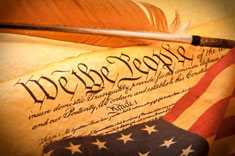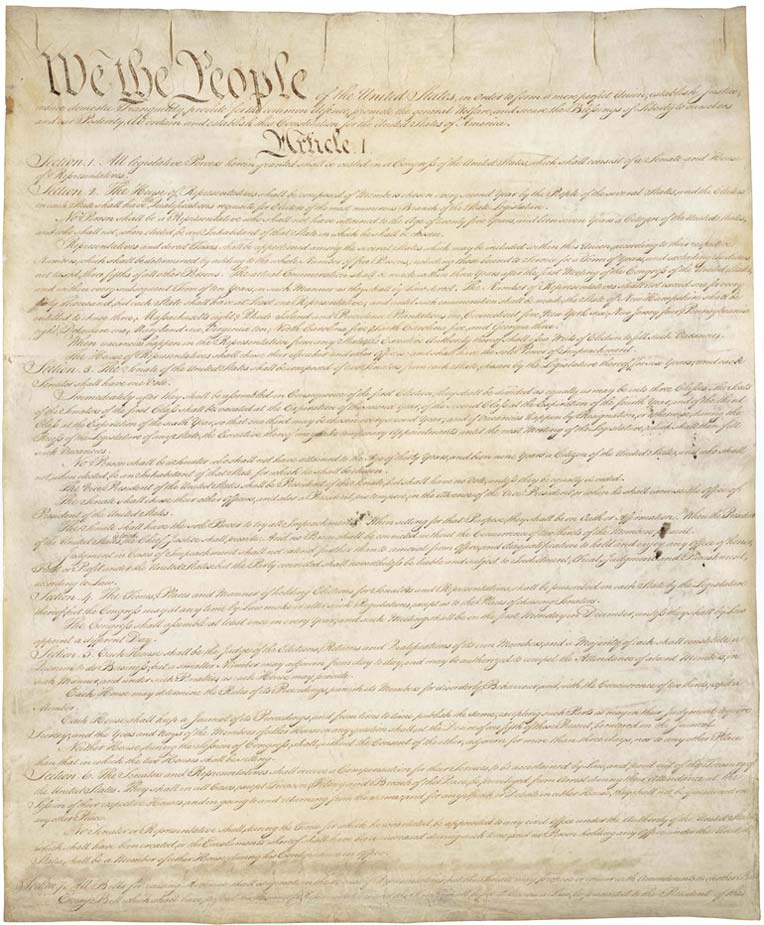| United States Constitution | |
|---|---|
 |
|
| The U.S. Constitution | |
| Preamble | |
| Articles of the Constitution | |
| I ‣ II ‣ III ‣ IV ‣ V ‣ VI ‣ VII | |
| Amendments to the Constitution | |
| Bill of Rights | |
| I ‣ II ‣ III ‣ IV ‣ V ‣ VI ‣ VII ‣ VIII ‣ IX ‣ X | |
| Additional Amendments | |
| XI ‣ XII ‣ XIII ‣ XIV ‣ XV ‣ XVI ‣ XVII ‣ XVIII ‣ XIX ‣ XX ‣ XXI ‣ XXII ‣ XXIII ‣ XXIV ‣ XXV ‣ XXVI ‣ XXVII | |
| View the Full Text | |
| Original Constitution | |
| Bill of Rights | |
| Additional Amendments |
Article 1 of the Constitution is where the powers of Congress, and any limits on those powers, are broken down and discussed. Congress makes up the legislative branch of the government, in turn, they are in charge of making the laws that go in to effect in the U.S. This article further breaks Congress down in to two distinct sections (bicameral legislature).
The Senate is the first of these two bodies, and this is comprised of two senators in each state. The second part is the House of Representatives, and this is made up of a number of representatives for each state, and this is determined by each state’s population.
Breaking it Down
The first article of the constitution is further broken down in to 10 distinct sections. In certain sections, there are further break downs, and clauses, discussing certain matters, and discussing in further detail, what each section in the article means.
Section 1: The Legislature
 This section is known as the vesting clause; it basically vests (gives) Congress the power to create the laws of the U.S. Article 2 and 3 have vesting clauses in them as well; these give the respective powers to the other government branches (judicial and executive). In turn, this provides a basic guideline, gives each branch their role, and discusses what each branch is in charge of, when it comes to government, and the way that the U.S., the states, and the people, are run and governed.
This section is known as the vesting clause; it basically vests (gives) Congress the power to create the laws of the U.S. Article 2 and 3 have vesting clauses in them as well; these give the respective powers to the other government branches (judicial and executive). In turn, this provides a basic guideline, gives each branch their role, and discusses what each branch is in charge of, when it comes to government, and the way that the U.S., the states, and the people, are run and governed.
Section 2: The House
This section provides information about the House of Representatives. It discusses how elections have to be held, in order to determine who will be a part of the house, and elections take place every second year. The people, all citizens of each state, are in charge of voting in the members of the House of Representatives. In order to run for a seat, an individual has to be at least 25 years old, must be a U.S. citizen, and must have been in the U.S. for a period of at least 7 years’ time; the individual is also required to live in the state that they want to represent.
Section 3: The Senate
This section explains the Senate. It discusses how each state will have 2 senators, and they will be appointed a term for 6 years as a state senator. In order for an individual to be voted in, the minimum age to run is 30 years old, they must be a U.S. citizen, and the period of time that they must have lived in the U.S. is 9 years, prior to running for this position. As with the House of Representatives, the individual that is running has to live in the state that they are running for.
Section 4: Elections, Meetings
This article discusses how each state has the power to determine where, how, and when the elections for the house of representative members, and the Senate members, will be elected in to office. It also discusses how it is a requirement for Congress to meet at least once annually, and the meeting has to be held on the first Monday in the month of December of any calendar year.
Section 5: Membership, Rules, Journals, Adjournment
Discusses the procedure for each of the houses of Congress. The issues that are discussed include the qualifications an individual must have, all the rules that the members are going to be required to follow, how to keep track of meetings, how to keep track of what happens in those meetings, and how the house can adjourn the meetings they do engage in.
Section 6: Compensation
This section takes a look at any restrictions, privileges, and the compensation to be paid, to anyone that is a member of the House of Representatives, or a senator. The U.S. Treasury is the entity that pays these individuals. It also discusses how these individuals can only be arrested if they are charged with a felony, breach of peace, or some kind of treason. It also states that while still in Congress, these individuals cannot take a position with the executive branch of government.
Section 7: Revenue Bills, Legislative Process, Presidential Veto
Discusses the manner in which Congress creates acts, through a series of bills. The proposed bill either begins in the House of Representatives or in the Senate; once both of these houses pass the bill, it can then be entered in to as a law. Once this takes place, it is sent up to the President, who then has the power to sign it in to law, or can veto the bill that is being proposed.
Section 8: Powers of Congress
This section lists the enumerated powers of the Congress; this is basically a list of things that Congress can and cannot do. Making money or creating their own tax schedules are a couple of the things that Congress does not have the power to do under these listed restrictions.
Section 9: Limits on Congress
In this section, the limits are listed. Like the enumerated powers that the members of Congress have, they are also limited in the acts they can do, and what they can engage in. All members of the House of Representatives and of the Senate, have to abide by, and are limited under the terms that are set out in this section of the constitution.
Section 10: Powers Prohibited of States
This final section in the Article 1 of the Constitution, is the one that puts a limit on the powers that each of the states have. The first part that is discussed, says the states do not have the power to act like, or do not have powers that the federal government has. It discusses what limits are set forth, and how the federal government, and all federal laws, are always going to trump the state’s laws, and what state officials have the power to do.
This article of the Constitution is basically explains law making and details what Congress has the power to do. The following sections of the Constitution further break down the power levels and structure. They discuss what each government entity and each governmental branch have the authority to do, as well as what they are limited from doing in their respective positions.